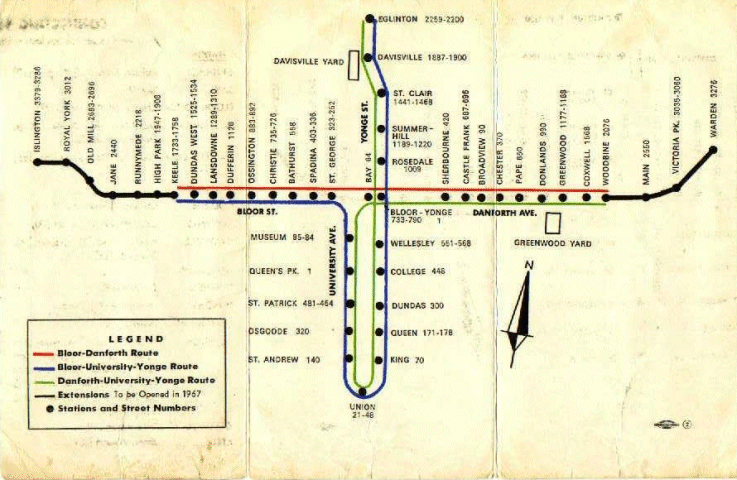Except that even a wye to the south wouldn't be enough to allow service trains to divert to the DRL - you would need a huge loop track either to the north/east or to the south-west to allow that to happen. And even then, you're going to have north/eastbound trains bypass Pape Station.
Considering the cost of what you're suggesting, and for the infinitesimally small number of times that it will be required, it's better to keep things separate - like the way that they are designing them.
Why would you need a loop track? St. George doesn't have one. The net cost difference between having it south of Danforth and north of Danforth is nil, not some kind of astronomical add-on.
The idea is that once the whole thing is running on ATC,
you could put the wye into play just like St. George with the interlining. During non-peak times, you could blend the service if there is room on the headway, so half the trains go directly downtown (there's an old DRL fantasy map by someone named dmz(?) floating around that I can't find that showed this better than I'm describing.) And yes, there are occasionally track-level disturbances on those 5 stations.

There are certainly many good options for heading west from Spadina. But I think Liberty Village will be quite well served with a combination of a GO RER/SmartTrack station and some kind of ROW along King. GO RER will shave off enough of the express trip patterns that the ROW can effectively service the local trip patterns. I'm not saying that a subway to Liberty Village wouldn't be a good idea, I just don't think it's the best option of what's available.
IMO it's of far greater utility to turn the RL north at Spadina and connect it with the Spadina Subway. That would put the wye back into play and allow B-D trains to head downtown, potentially negating the need for a billion dollar expansion of Bloor-Yonge.
IMO making it sharply turn north onto Spadina would be a huge mistake, although this shows up on a few fantasy maps.
You would be running under a corridor that already has rapid transit coverage, within a couple hundred meters of another rapid transit line. Why would you do that when there is so much potential ridership from continuing west?
If relieving St. George is a concern then you could do that by building the full downtown U and actually improve transit coverage in a large densely populated employment district instead of duplicating existing services.
In my view, assuming Relief Line on Queen (with local Queen Streetcar), better King Streetcar priority, and RER/ST, having a spread out load between Relief Line and RER, both being "express" services (insert SSE Express Subway joke here) will allow for more choice for riders coming in and out of the Downtown Core.
This is just my view and it might be wrong, but if there Relief Line was on King, the "centre" of the downtown offices, then EVERYONE would take the King Subway and it will be at capacity. Very little people will chose RER or the local streetcar routes as the subway is right next to where they work.
The relief line would be too crowded if it were on King
Generally, when building ultra-expensive deep-bore subway stations we should be trying to maximize ridership to make the most effective use of our new high capacity line. Unless we are talking about the Scarborough subway extension, in which case there is no need to match mode to ridership
 Nobody would take the streetcar
Nobody would take the streetcar
We shouldn't be gerrymandering the route in order to preserve parallel surface routes out of a sense of sentimentality. If more people take the subway on King, it means that it's a more convenient option for them. There is still a role for streetcars downtown (Spadina, Bathurst, Queens Quay, College, Cherry, Dundas, etc.), but it is normal and much more cost effective to have a new subway line absorb the ridership of the surface routes that it replaces.
Besides, I'm worried that switching back and forth between King and Queen would do more to pilfer ridership than just staying on one street and letting the other function as a one-seat-ride local line for those who don't want to transfer. If it overlaps with both lines, then you enter a "transit death spiral" where ridership drops cause service drops which cause more ridership drops.
Nobody would take RER
Union station is already bursting at the seams with all the ridership from the 'burbs. Metrolinx is looking at Union relief with the same seriousness that the city of Toronto is looking at Yonge line relief. The relief line serves Union relief by offloading GO demand before it reaches Union, allowing people to transfer to be closer to their destinations.
With the projected increase in GO ridership with RER, siphoning GO ridership should be the least of our concerns.
King is within the Union catchment. A DRL at Queen pulls people up from Richmond/Adelaide but also down from the Dundas direction. One other important thing to consider is the lower core as a single point of failure. In the event of a security event in the King-Union stretch, or a power failure, it is conceivable that DRL, Line 1 and Union would all stop service at the same time. Spacing the services further apart likely improves total resilency.
I don't see what conceivable situation could cause a security event impacting underground transit within a 500 metre radius of Union but not an 800 metre radius of Union. Neither alignments have a single point of failure. There is zero impact on resiliency.
